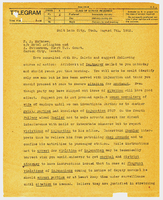Search the Special Collections and Archives Portal
Search Results

Photographs of McCarran Field signs, Las Vegas (Nev.), 2002
Date
Archival Collection
Description
Site address: 6005 S Las Vegas Blvd
Sign owner: McCarran International Airport
Sign details: On the south end of the Strip, the very last sign on the east side before you arrive at Sunset Blvd Facing West the two stone pylons are set approximately fifty feet off of the street at the end of a dual-lane stretch of pavement separated by an island of grass. The banner marquis between the two pylons stretches over this area of grass.
Sign condition: Structure 3 Surface 3 Lighting 4 Notes: The surface of the pylon is in good shape considering its age and its environmental condition. It is essentially left to fend for itself against the elements, being in the flat expanse of an airfield. The stone, plaques, and paint treatment are all badly worn, with the stone pylons, appearing the least worn.
Sign form: Pylon
Sign-specific description: The original McCarran Air Field entrance is constructed of two masonry pylons sit on an island of grass, and serve as an entrance to the private Hughes executive airport terminal. Each individual tower is adorned with a propeller attached to the front and the representation of a bird's wing crowning the tops Both facets are constructed of steel. When facing the structures the left has a plaque on the bottom section with the inscription "1948" while the one on the right reads "Las Vegas". Between the two pylons a stretch of text in white channel letters and white neon, large text in the old "Frontier style text reads McCarran Airport. The signage sits independently on top of a sturdy connecting steel cabinet, which supports the words "executive terminal" in smaller channel letters, with white neon. The cabinet is a painted blue horizontal plane tapering wider on either end in rounded profile patterns. The wings are outlined in pink neon, while the propellers are outlined in rose neon with a circle of white in the middle.
Sign - type of display: Neon
Sign - media: Masonry
Sign - non-neon treatments: Paint
Sign animation: none
Sign environment: The surrounding area is rather dark due to the wide expanse of the airfield which stretches out behind the sign. It truly is a last marker for the end of the Strip, and stands alone. Even though it is in close proximity to the major strip resorts of the Four Seasons as well as the Mandalay Bay and various small roadside hotels, it seems to stand in solitude.
Sign - date of installation: 1948
Sign - date of redesign/move: The blue banner of steel and white letters was added after its initial construction.
Sign - thematic influences: The masonry pylons are constructed in an adobe style masonry reminiscent of the desert landscape surroundings. Designed for the airport, the appendages stem obviously around the theme of flight. This may be denoted from the propeller and the wing. The juxtaposition of the two elements, one being the method of flight in nature and the other man made, serves as a reminder of mans fascination with flight. The added banner's text is in the pioneer fashion of the original Last Frontier.
Sign - artistic significance: Opened in 1948, the sign was intended for use as a marker for the endpoint of the Strip. " It was part of the city's expanding policy creating a jet-scale entrance for the city," Jorg Rudemer from Lost Las Vegas. Artistic significance also lies in the combination of materials using masonry, steel and, neon. The piece successfully combined these elements to provide an architecturally solid design by day, which was cohesive with its surrounding landscape. A metamorphosis takes place at night as the sign is transformed into a glowing specter of its daytime counterpart. The surrounding area is rather dark as the pylon rises up out of the darkness as a neon marker for the property. The illuminated wing and propeller stand out as the significant and successful partners in the world of flight.
Surveyor: Joshua Cannaday
Survey - date completed: 2002
Sign keywords: Pylon; Neon; Masonry; Paint
Mixed Content
Skaggs, Robert L.
Dr. Robert Skaggs was born April 2, 1932 and grew up around the St. Louis, Missouri area. His father was a teamster with a milk delivery route, tried his hand at the restaurant business, and during World War II worked for the United States Cartridge. Several members of Skaggs’s family were teachers, including his grandmother and a couple of aunts. Skaggs graduated from Normandy High School and afterwards attended the Missouri School of Mines and majored in metallurgical engineering. He graduated in 1954 and went to work for DuPont University for two years.
Person
Henderson, Betty, 1923-1985
Betty Henderson was a private music teacher in Las Vegas, Nevada and dedicated member of the Nevada Music Teachers Association. She was born on January 23, 1923 in Portland, Indiana. She wanted to pursue a career in music and enrolled at the Cincinnati Conservatory of Music, but was forced to drop out after she started to become deaf. She married Charles B. Henderson, a civil engineer, in 1948 and moved to Las Vegas, Nevada. She had many different jobs in the city including secretary and company auditor.
Person
Morlan, Jerry Duane, 1938-2000
Jerry Duane Morlan (1938-2000) was born and raised in Victorville, California. He worked as a letter carrier for the U.S. Post Office from 1960 to 1965 before his eight-year tenure as an industrial photographer at Teledyne Semiconductor in Hawthorne, California. After Teledyne, Morlan was a successful general supervisor of the graphic arts department of leading toy manufacturing company Mattel, continuing to work as a photographer and sometimes acting as a consultant for the Yankee Photo Products company.
Person
Hinds, James R.
James Roland Hinds, better known as Jim, was the Nellis Air Force base historian and a novelist in Las Vegas, Nevada. He was born in Okmulgee, Oklahoma on December 8, 1937. Shortly after his birth, his parents became civil service employees and moved the family to Washington, D.C., where James grew up. He recieved his bachelor's from Washington University in St. Louis, Missouri and his master's degree from Southern Illinois University in 1964. After that, he served in the United States Army for two years.
Person
Elliott, Estrellita
"Interviewed by Vanessa Concepcion and Stefani Evans. Twins Estrellita "Estelle" and Julieta "Julia" Elliott were born in Manila and raised in Cebu City by their maternal grandparents. Their lawyer grandfather and Spanish professor grandmother raised them with a tricultural identity (Spanish, Filipino, and American) but with emphasis on their Castilian Spanish heritage. When they were twelve and their grandfather died, they went to live with their parents in Maryland, where their father was an educator and author and their mother was a concert pianist.
Person
Elliott, Julieta
"Interviewed by Vanessa Concepcion and Stefani Evans. Twins Estrellita "Estelle" and Julieta "Julia" Elliott were born in Manila and raised in Cebu City by their maternal grandparents. Their lawyer grandfather and Spanish professor grandmother raised them with a tricultural identity (Spanish, Filipino, and American) but with emphasis on their Castilian Spanish heritage. When they were twelve and their grandfather died, they went to live with their parents in Maryland, where their father was an educator and author and their mother was a concert pianist.
Person

Telegram from A. S. Halsted to Frank R. McNamee, August 7, 1922
Date
Archival Collection
Description
Text
